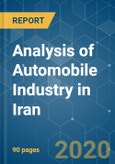The Iranian automobile industry stands as the 12th largest automaker in the world. With the total sales of USD 12 billion, it makes up for approximately 19% of the total industry, as well as for approximately 2.5% - 3% of Iran’s GDP. Furthermore, it is responsible for 14% added value creation contribution to the whole industry. The average profit of the industry is 4.5%.
As Iran is one of the major vehicle manufacturing countries in the Middle Eastern region, it exports its vehicles and spare parts to its neighboring countries. In 2012 Iran exported USD 520 million worth of automobiles and car components. However, in 2013 and 2014, the export situation became worse and it could only export USD 263 million and USD 243 million, respectively. There are several reasons for the drop, however, the key reasons include low quality and high prices.
Key Market Trends
Passenger Car Sales Dominating the Iran Automobile Industry
The international sanctions have had a tremendous impact on the industrial development of many industries in the country. Iran, which is the largest automotive market in the Middle East with a market of nearly one-third of the German automotive market, has seen a drop in the automotive industry with the implementation of the sanctions.
Eventually, the Iranian automotive industry became self-reliant and self-sufficient to supply for the demand within the country. The country had reached the potential to roll out more than a million vehicles. Ever since the implementation of the sanctions, the demand for vehicles is being met by the vehicles manufactured in the country only.
The sanctions gave birth to domestic companies, such as IKCO and SAIPA, which have a major share of the passenger vehicle sales in the country. At the time of implementation of the sanctions, the percentage share of the indigenous companies of the overall vehicle production reached as high as 85%. However, with the removal of the sanctions, the domestic companies are expected to join forces with international companies, such as Peugeot, Daimler, and Jaguar, etc., to introduce the latest vehicles in the country.
Decrease in Vehicle Production due to Imposed Sanctions
In 2016, the automotive industry manufactured more than 946,000 vehicles, which indicates a 38.7% growth year-on-year. After this surge in the automotive production, multinational companies started taking interest in investing in the country, followed by the nuke deal signed in January 2015, which had attracted attention to Iran’s automotive industry. For Instance;
Peugeot partnered with the local leading company, Iran Khodro, to manufacture passenger vehicles. Khodro is already behind schedule for advance bookings. The partnership, which signed a EUR 400 million (USD 430 million) deal in June 2016, expects to produce 200,000 cars in Iran by 2018.
In February 2018, Renault sold nearly 15,200 cars in Iran, which is an increase by 175% from the fiscal year 2017.
The Iranian car manufacturers have re-established their cooperation with European companies, such as Peugeot, Citroen, and Renault. As a result, the automotive industry has grown by nearly 151%. Additionally, a couple of years back, the Islamic Republic presented certificates to foreign car manufacturers willing to open sales branches in Iran. Around 40 foreign automotive manufacturers have already obtained the certificates, and the number is projected to grow over the forecast period.
However, the production of new vehicles in 2018 in Iran have slightly decreased due to currency crisis and other byproducts of sanctions. Internation automobile companies which produced cars in Iran such as Peugeot and Renault have decided to stop their operations because U.S. sanctions were also imposed on any company that did business with Tehran. Renewed sanctions led to delays in car deliveries and a shortage of parts.
However, during March 2019, Deputy Minister of Industry, Mines and Trade, announced that a new mechanism has been devised for the French company which will allow it to resume manufacturing in Iran despite U.S. sanctions. This is expected to boost the Iran automobile industry over the forecast period.
Competitive Landscape
There are many major local players in the country, such as IKCO, SAIPA, Pars Khodro, Kerman, Iran Khodro, and Bahman, who manufacture a variety of different models (such as Samand, Tiba, Dena, etc.). IKCO and SAIPA are the biggest automotive manufacturers.
Reasons to Purchase this report:
- The market estimate (ME) sheet in Excel format
- 3 months of analyst support
Table of Contents
Companies Mentioned (Partial List)
A selection of companies mentioned in this report includes, but is not limited to:
- Automobile Manufacturers
- Auto Component Manufacturers








